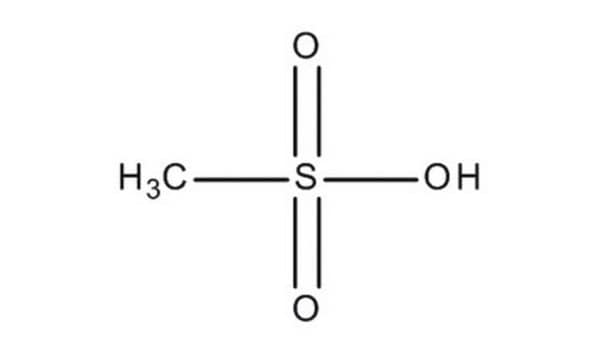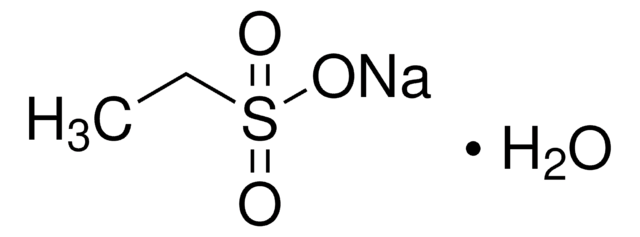Products may be shipped at a different temperature than the recommended long-term storage temperature. If the product quality is sensitive to short-term exposure to conditions other than the recommended long-term storage, it will be shipped on wet or dry-ice. If the product quality is NOT affected by short-term exposure to conditions other than the recommended long-term storage, it will be shipped at ambient temperature. As shipping routes are configured for minimum transit times, shipping at ambient temperature helps control shipping costs for our customers. For more information, please refer to the Storage and Transport Conditions document: https://www.sigmaaldrich.com/deepweb/assets/sigmaaldrich/marketing/global/documents/316/622/storage-transport-conditions-mk.pdf
471356
Methanesulfonic acid
≥99.0%
Sinónimos:
Mesylic acid, MsOH
Seleccione un Tamaño
46,70 €
Seleccione un Tamaño
About This Item
46,70 €
Productos recomendados
densidad de vapor
3.3 (vs air)
[3.3 (vs air)] (vs air)
Nivel de calidad
presión de vapor
1 mmHg ( 20 °C)
Ensayo
≥99.0%
Formulario
liquid
índice de refracción
n20/D 1.429 (lit.)
intervalo de pH
<1
bp
[167 °C/10 mmHg (lit.)]
167 °C/10 mmHg (lit.)
mp
17-19 °C (lit.)
solubilidad
water: soluble 1,000 g/L at 20 °C
densidad
1.481 g/mL at 25 °C (lit.)
grupo funcional
sulfonic acid
cadena SMILES
O=S(O)(C)=O
InChI
1S/CH4O3S/c1-5(2,3)4/h1H3,(H,2,3,4)
Clave InChI
AFVFQIVMOAPDHO-UHFFFAOYSA-N
¿Está buscando productos similares? Visita Guía de comparación de productos
Descripción general
Aplicación
- As a catalyst to produce linear alkylbenzenes by the addition reaction between long-chain olefins and benzene.[4]
- To prepare polyaniline (PANI)/graphene composites with enhanced thermal and electrical properties.[5]
- As a catalyst for the transformation of glucose/xylose mixtures to levulinic acid and furfural.[6]
Palabra de señalización
Danger
Frases de peligro
Consejos de prudencia
Clasificaciones de peligro
Acute Tox. 4 Dermal - Acute Tox. 4 Oral - Eye Dam. 1 - Met. Corr. 1 - Skin Corr. 1B - STOT SE 3
Órganos de actuación
Respiratory system
Código de clase de almacenamiento
8A - Combustible corrosive hazardous materials
Clase de riesgo para el agua (WGK)
WGK 1
Punto de inflamabilidad (°F)
372.2 °F - closed cup
Punto de inflamabilidad (°C)
189 °C - closed cup
Equipo de protección personal
Faceshields, Gloves, Goggles, type ABEK (EN14387) respirator filter
Elija entre una de las versiones más recientes:
¿Ya tiene este producto?
Encuentre la documentación para los productos que ha comprado recientemente en la Biblioteca de documentos.
Los clientes también vieron
-
How is shipping temperature determined? And how is it related to the product storage temperature?
1 respuesta-
¿Le ha resultado útil?
-
-
How can I determine the shelf life / expiration / retest date of this product?
1 respuesta-
If this product has an expiration or retest date, it will be shown on the Certificate of Analysis (COA, CofA). If there is no retest or expiration date listed on the product's COA, we do not have suitable stability data to determine a shelf life. For these products, the only date on the COA will be the release date; a retest, expiration, or use-by-date will not be displayed.
For all products, we recommend handling per defined conditions as printed in our product literature and website product descriptions. We recommend that products should be routinely inspected by customers to ensure they perform as expected.
For products without retest or expiration dates, our standard warranty of 1 year from the date of shipment is applicable.
For more information, please refer to the Product Dating Information document: https://www.sigmaaldrich.com/deepweb/assets/sigmaaldrich/marketing/global/documents/449/386/product-dating-information-mk.pdf¿Le ha resultado útil?
-
-
What is the method of synthesis of this? Does it start with methane sulfonyl chloride?
1 respuesta-
Methods of preparation for this product are considered proprietary.
¿Le ha resultado útil?
-
Filtros activos
Nuestro equipo de científicos tiene experiencia en todas las áreas de investigación: Ciencias de la vida, Ciencia de los materiales, Síntesis química, Cromatografía, Analítica y muchas otras.
Póngase en contacto con el Servicio técnico







